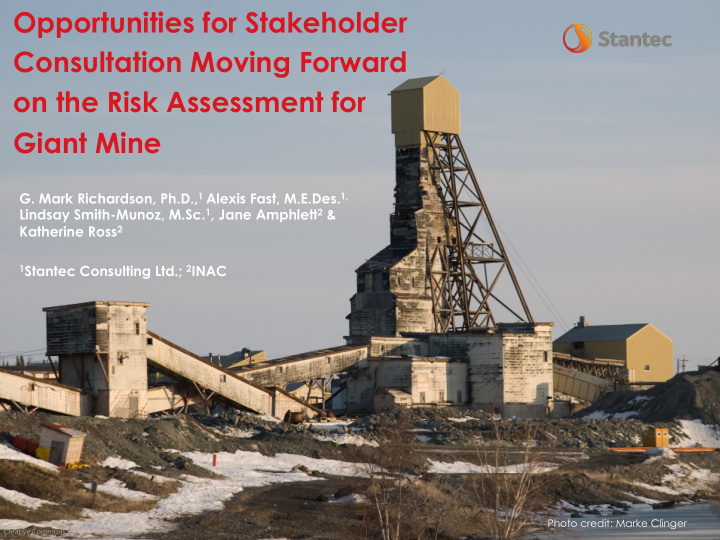



Opportunities for Stakeholder Consultation Moving Forward on the Risk Assessment for Giant Mine G. Mark Richardson, Ph.D., 1 Alexis Fast, M.E.Des. 1, Lindsay Smith-Munoz, M.Sc. 1 , Jane Amphlett 2 & Katherine Ross 2 1 Stantec Consulting Ltd.; 2 INAC Photo credit: Marke Clinger
To date, consultation has occurred with the Giant Mine Working Group and the Giant Mine Advisory Committee on the approach to and content of the Problem Formulation for the next Giant Mine Risk Assessment. This talk relates to what further stakeholder consultation should be considered as the full risk assessment is conducted.
Mackenzie Valley Review Board Conclusion “The Review Board finds as fact that the human health risk assessment does not provide an adequate basis for identifying, evaluating and avoiding impacts to human health from the proposed Project.” This Conclusion was reached (in part) due to a lack of public involvement: MVRB Suggestion 1: The Developer should further consult with surrounding communities, including Dettah, Ndilo and the City of Yellowknife...
What is Stakeholder Consultation? Consultation is NOT simply telling stakeholders what you are doing Or what you have done. Proper consultation establishes a working relationship and is the foundation for working together. Proper consultation is asking stakeholders what they think you should do, and ultimately if they think you are doing it adequately. Stakeholders should determine the extent to which they want to contribute to the risk assessment process.
Risk Assessment is a Process C o PROBLEM FORMULATION n s • Chemicals of potential concern u • Receptors l t • Exposure pathways a t i o EXPOSURE ASSESSMENT n TOXICITY ASSESSMENT • What dose do receptors • What dose is safe ? get? RISK CHARACTERIZATION • Is dose received > or < safe dose?
Potential Receptors Specific geographic areas: o General populace of Yellowknife o Residents of Ndilo o Other residents of Latham Island o Residents of Dettah o Campers using local camping areas o Recreational users of boat launch o Residents near the Ingraham Trail o Residents of the Bayly residence Unique community members: o Students of K'àlemì Dene School in Ndilo (fish lunches) o Children of Ndilo wading/playing in shore sediments o Consumers of fish, game, country foods and medicinal plants o Residents relying on surface water for drinking water o Residents using backyard or community garden produce o Giant Mine remediation workers
Giant Mine Stakeholders consulted by Stantec for Problem Formulation development Giant Mine Working Group (GMWG), which includes staff from: • The Yellowknives Dene First Nation (YKDFN) • North Slave Metis Alliance (NSMA) • Alternatives North • Environment Canada • Health Canada • Fisheries and Oceans Canada • City of Yellowknife • Indigenous and Northern Affairs Canada (INAC) • Public Works and Government Services Canada (PWGSC) • Government of the Northwest Territories (GNWT) • Giant Mine Advisory Committee (GMAC), including representatives of: • Youth, Elders, Business and former Chief of the YKDFN •
Other potential Giant Mine Stakeholders as the Risk Assessment moves forward The YKDFN Elders Senate and Chief/Council • The Giant Mine Oversight Body • The Northwest Territories Territorial Farmers Association • The Hunters and Trappers Association • The Yellowknife Gardeners Association • Great Slave Sailing Club • NWT Mining Heritage Society • Giant Mine Community Alliance (GMCA) • General populace of Yellowknife •
Aspects of Risk Assessment requiring consultation for progress Identifying need for revision of or changes to Problem Formulation • Additional receptors • Additional exposure pathways • Unique exposure scenarios • Other (obvious to stakeholders but not so obvious to risk assessor) • Joint fact-finding (further data collection) (see next slide) • Credit: David K. Credit: CambridgeBayWeather Credit: Wikipedia Credit: Alex Anlicker
Aspects of Risk Assessment requiring consultation for joint fact-finding Identifying locations used for hunting, fishing, country food gathering • Identifying species hunted, fished, gathered • Credit: Stantec Credit: Stantec Credit: Stantec Credit: D. Gordon E. Robertson Credit: Stantec Credit: Stantec Credit: Stantec
Aspects of Risk Assessment requiring consultation for joint fact-finding (cont.) Defining the need for additional data • If additional data are needed, defining the sampling plans for flora, • fauna, soil, etc., and the geographic locations where these additional data should be collected Food use frequency surveys • YKDFN and Metis hunters, fishers, and harvesters of other local country foods • Users and consumers of backyard and community garden produce •
Project ¡ini;a;on ¡mee;ng ¡with ¡Client; Stakeholder ¡ Proposal ¡for ¡sampling; Walk-‑over ¡of ¡Site ¡and ¡communi;es ¡of ¡focus; Conduct ¡sampling consulta)on ¡prior ¡to ¡ Proceed ¡upon ¡approval Introduc)on ¡to ¡Stakeholders ¡and ¡ini)al ¡consulta)on ini)a)on Proposal ¡for Stakeholder ¡ Review ¡of ¡background ¡reports ¡and ¡available ¡data; bioaccessibility ¡tes;ng; Conduct ¡tes;ng consulta)on ¡prior ¡to ¡ Review ¡and ¡revision ¡of ¡the ¡Problem ¡Formula;on Proceed ¡upon ¡approval ini)a)on Stakeholder ¡consulta)on ¡regarding ¡revisions ¡to ¡ Joint ¡fact-‑finding: Problem ¡Formula)on Food ¡preferences, ¡food ¡ Stakeholder ¡ Conduct ¡fact-‑ consulta)on ¡and ¡ use, ¡harvest ¡loca;ons ¡ finding etc.; par)cipa)on Proceed ¡upon ¡approval DraH ¡determinis;c ¡DQHHRA: ¡ Background ¡case ¡(sources ¡unrelated ¡to, ¡or ¡not ¡impacted ¡by, ¡Giant ¡Mine ¡ • opera;ons) Current ¡case ¡(current ¡condi;ons) • Future ¡case ¡(100 ¡years ¡aHer ¡implementa;on ¡of ¡Giant ¡Mine ¡Remedia;on ¡Project) • Propose ¡future ¡monitoring ¡program(s) ¡as ¡part ¡of ¡the ¡conclusions ¡and ¡ • recommenda;ons ¡of ¡the ¡DQHHRA Stakeholder ¡consulta)on ¡on ¡results ¡of ¡Dra< ¡DQHHRA Final ¡DQHHRA
Questions?
Recommend
More recommend